TOYOTA YARIS HYBRID 2013 Repair Manual
Manufacturer: TOYOTA, Model Year: 2013, Model line: YARIS HYBRID, Model: TOYOTA YARIS HYBRID 2013Pages: 700, PDF Size: 28.68 MB
Page 61 of 700
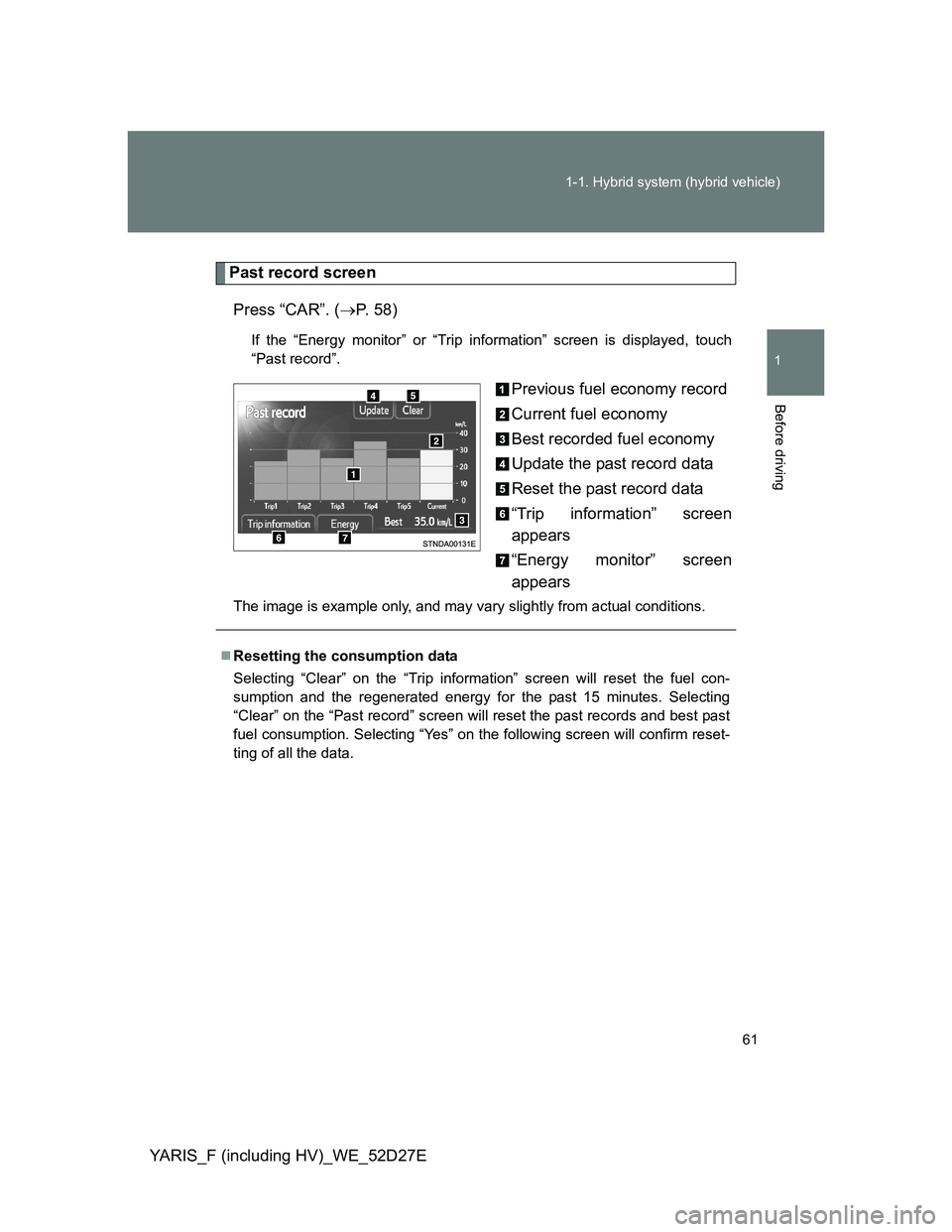
61 1-1. Hybrid system (hybrid vehicle)
1
Before driving
YARIS_F (including HV)_WE_52D27E
Past record screen
Press “CAR”. (P. 58)
If the “Energy monitor” or “Trip information” screen is displayed, touch
“Past record”.
Previous fuel economy record
Current fuel economy
Best recorded fuel economy
Update the past record data
Reset the past record data
“Trip information” screen
appears
“Energy monitor” screen
appears
The image is example only, and may vary slightly from actual conditions.
Resetting the consumption data
Selecting “Clear” on the “Trip information” screen will reset the fuel con-
sumption and the regenerated energy for the past 15 minutes. Selecting
“Clear” on the “Past record” screen will reset the past records and best past
fuel consumption. Selecting “Yes” on the following screen will confirm reset-
ting of all the data.
Page 62 of 700
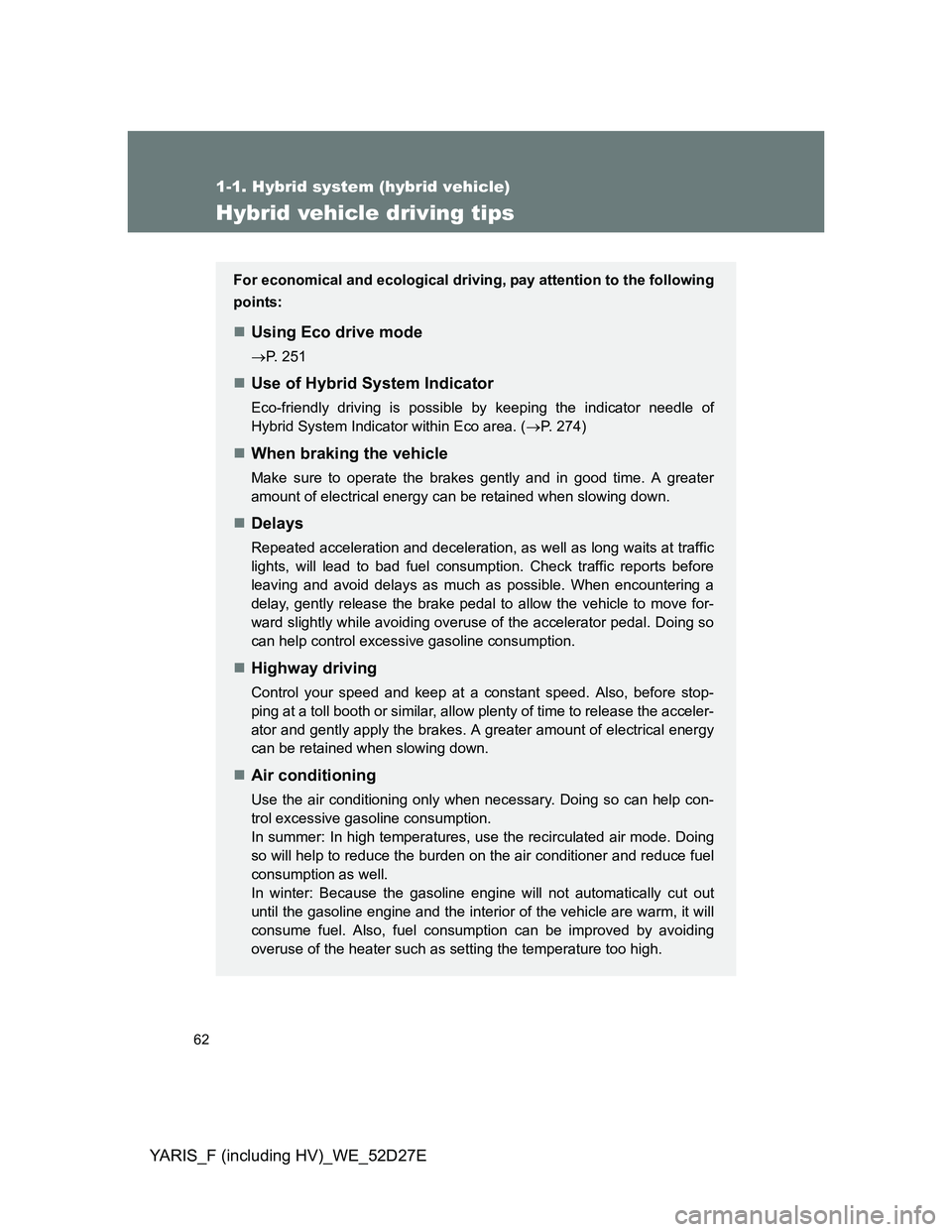
62
1-1. Hybrid system (hybrid vehicle)
YARIS_F (including HV)_WE_52D27E
Hybrid vehicle driving tips
For economical and ecological driving, pay attention to the following
points:
Using Eco drive mode
P. 251
Use of Hybrid System Indicator
Eco-friendly driving is possible by keeping the indicator needle of
Hybrid System Indicator within Eco area. (P. 274)
When braking the vehicle
Make sure to operate the brakes gently and in good time. A greater
amount of electrical energy can be retained when slowing down.
Delays
Repeated acceleration and deceleration, as well as long waits at traffic
lights, will lead to bad fuel consumption. Check traffic reports before
leaving and avoid delays as much as possible. When encountering a
delay, gently release the brake pedal to allow the vehicle to move for-
ward slightly while avoiding overuse of the accelerator pedal. Doing so
can help control excessive gasoline consumption.
Highway driving
Control your speed and keep at a constant speed. Also, before stop-
ping at a toll booth or similar, allow plenty of time to release the acceler-
ator and gently apply the brakes. A greater amount of electrical energy
can be retained when slowing down.
Air conditioning
Use the air conditioning only when necessary. Doing so can help con-
trol excessive gasoline consumption.
In summer: In high temperatures, use the recirculated air mode. Doing
so will help to reduce the burden on the air conditioner and reduce fuel
consumption as well.
In winter: Because the gasoline engine will not automatically cut out
until the gasoline engine and the interior of the vehicle are warm, it will
consume fuel. Also, fuel consumption can be improved by avoiding
overuse of the heater such as setting the temperature too high.
Page 63 of 700
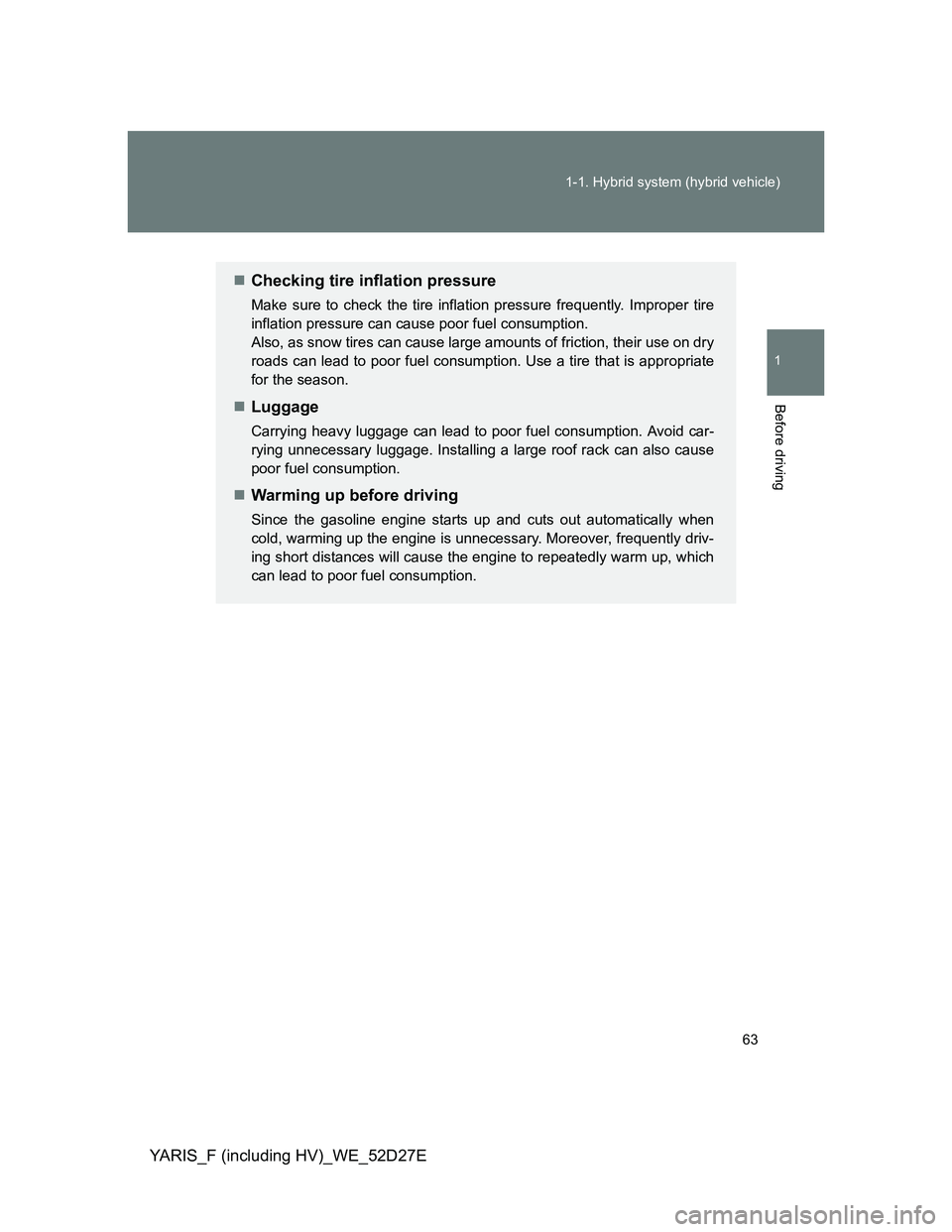
63 1-1. Hybrid system (hybrid vehicle)
1
Before driving
YARIS_F (including HV)_WE_52D27E
Checking tire inflation pressure
Make sure to check the tire inflation pressure frequently. Improper tire
inflation pressure can cause poor fuel consumption.
Also, as snow tires can cause large amounts of friction, their use on dry
roads can lead to poor fuel consumption. Use a tire that is appropriate
for the season.
Luggage
Carrying heavy luggage can lead to poor fuel consumption. Avoid car-
rying unnecessary luggage. Installing a large roof rack can also cause
poor fuel consumption.
Warming up before driving
Since the gasoline engine starts up and cuts out automatically when
cold, warming up the engine is unnecessary. Moreover, frequently driv-
ing short distances will cause the engine to repeatedly warm up, which
can lead to poor fuel consumption.
Page 64 of 700
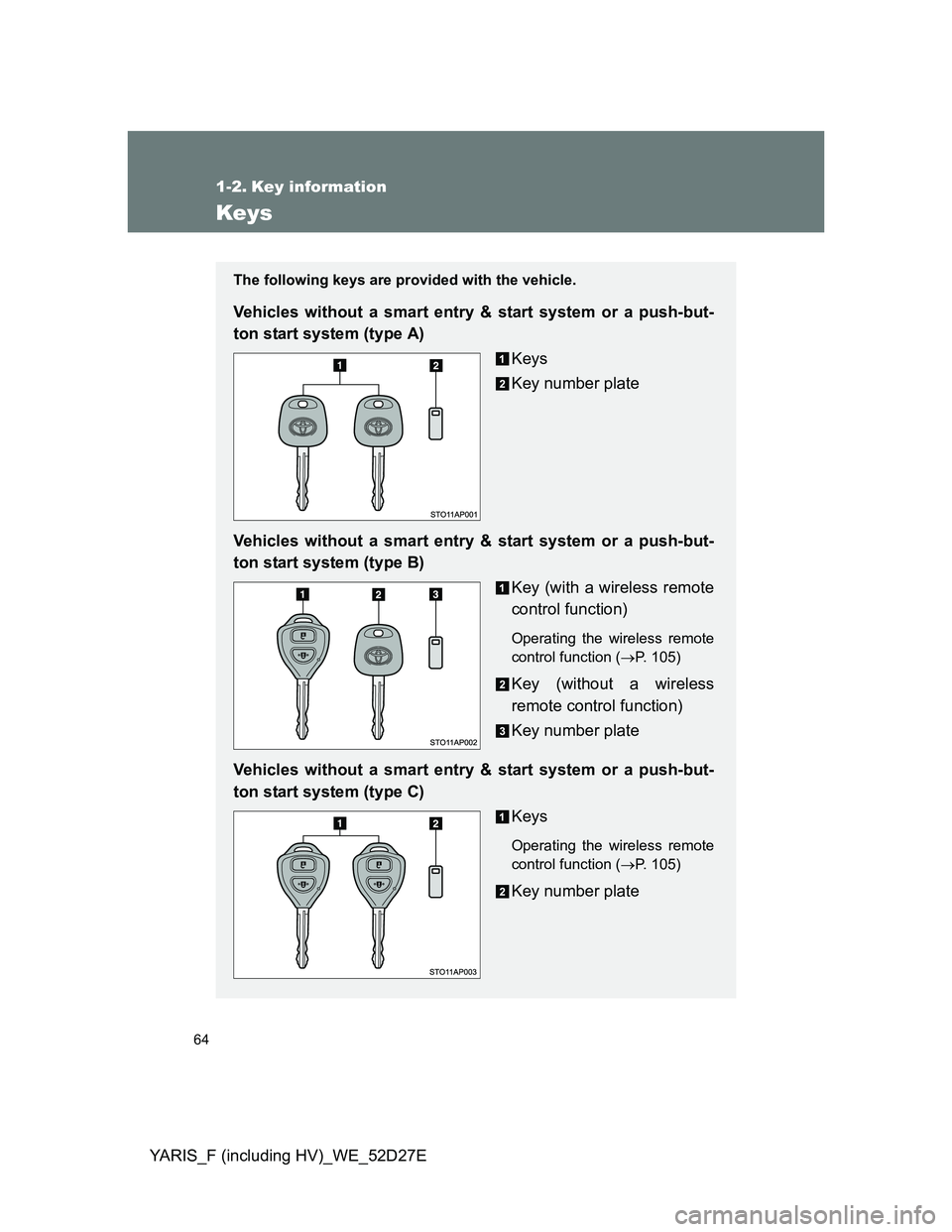
64
YARIS_F (including HV)_WE_52D27E
1-2. Key information
Keys
The following keys are provided with the vehicle.
Vehicles without a smart entry & start system or a push-but-
ton start system (type A)
Keys
Key number plate
Vehicles without a smart entry & start system or a push-but-
ton start system (type B)
Key (with a wireless remote
control function)
Operating the wireless remote
control function (P. 105)
Key (without a wireless
remote control function)
Key number plate
Vehicles without a smart entry & start system or a push-but-
ton start system (type C)
Keys
Operating the wireless remote
control function (P. 105)
Key number plate
Page 65 of 700

65 1-2. Key information
1
Before driving
YARIS_F (including HV)_WE_52D27E
Vehicles with a smart entry & start system (type A)
Electronic keys
• Operating the smart entry &
start system (P. 69)
• Operating the wireless
remote control function
(P. 105)
Mechanical keys
Key number plate
Vehicles with a smart entry & start system (type B)
Electronic keys
• Operating the smart entry &
start system (P. 69)
• Operating the wireless
remote control function
(P. 105)
Mechanical keys
Key number plate
Vehicles with a push-button start system
Electronic keys
• Operating the push-button
start system (P. 94)
• Operating the wireless
remote control function
(P. 105)
Mechanical keys
Key number plate
Page 66 of 700
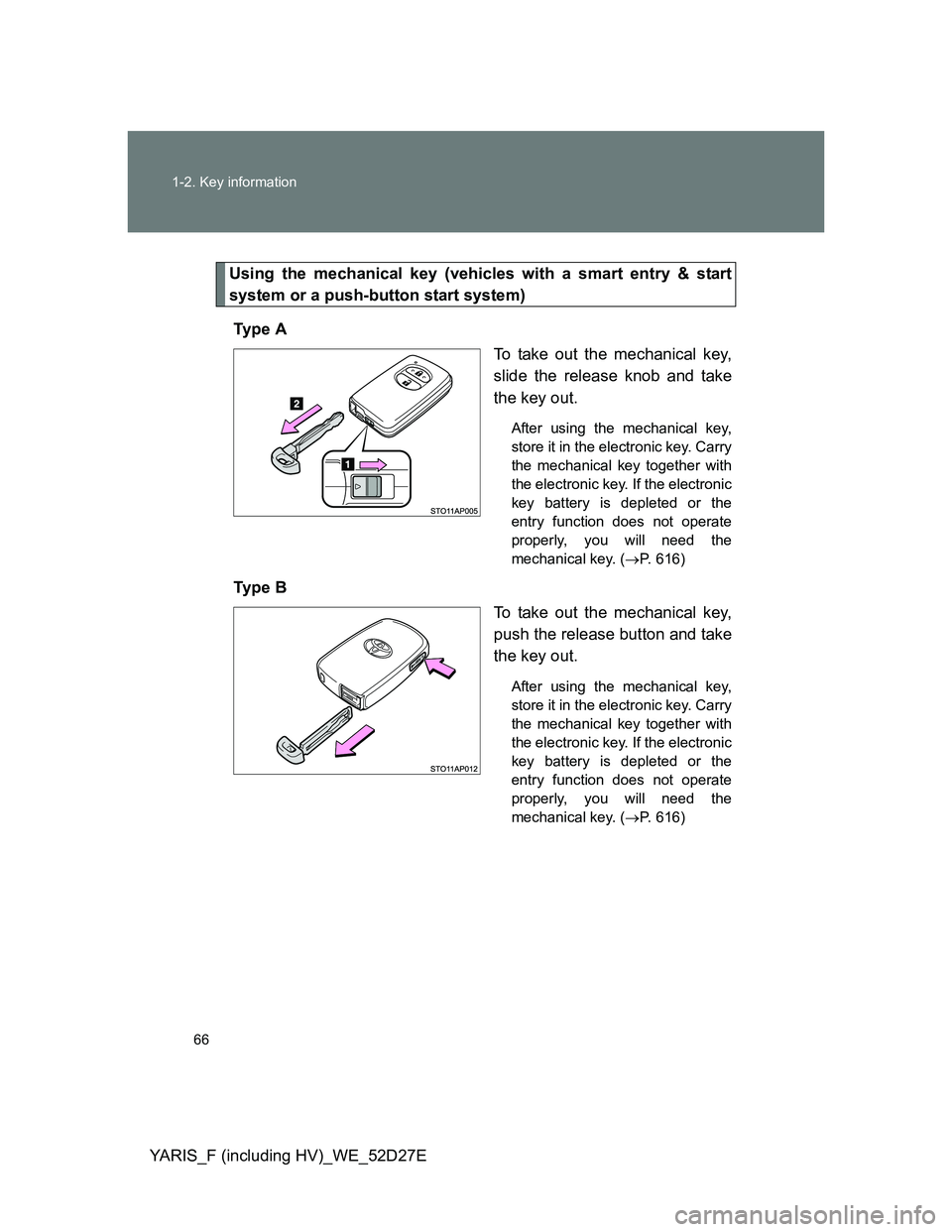
66 1-2. Key information
YARIS_F (including HV)_WE_52D27E
Using the mechanical key (vehicles with a smart entry & start
system or a push-button start system)
Ty p e A
To take out the mechanical key,
slide the release knob and take
the key out.
After using the mechanical key,
store it in the electronic key. Carry
the mechanical key together with
the electronic key. If the electronic
key battery is depleted or the
entry function does not operate
properly, you will need the
mechanical key. (P. 616)
Ty p e B
To take out the mechanical key,
push the release button and take
the key out.
After using the mechanical key,
store it in the electronic key. Carry
the mechanical key together with
the electronic key. If the electronic
key battery is depleted or the
entry function does not operate
properly, you will need the
mechanical key. (P. 616)
Page 67 of 700
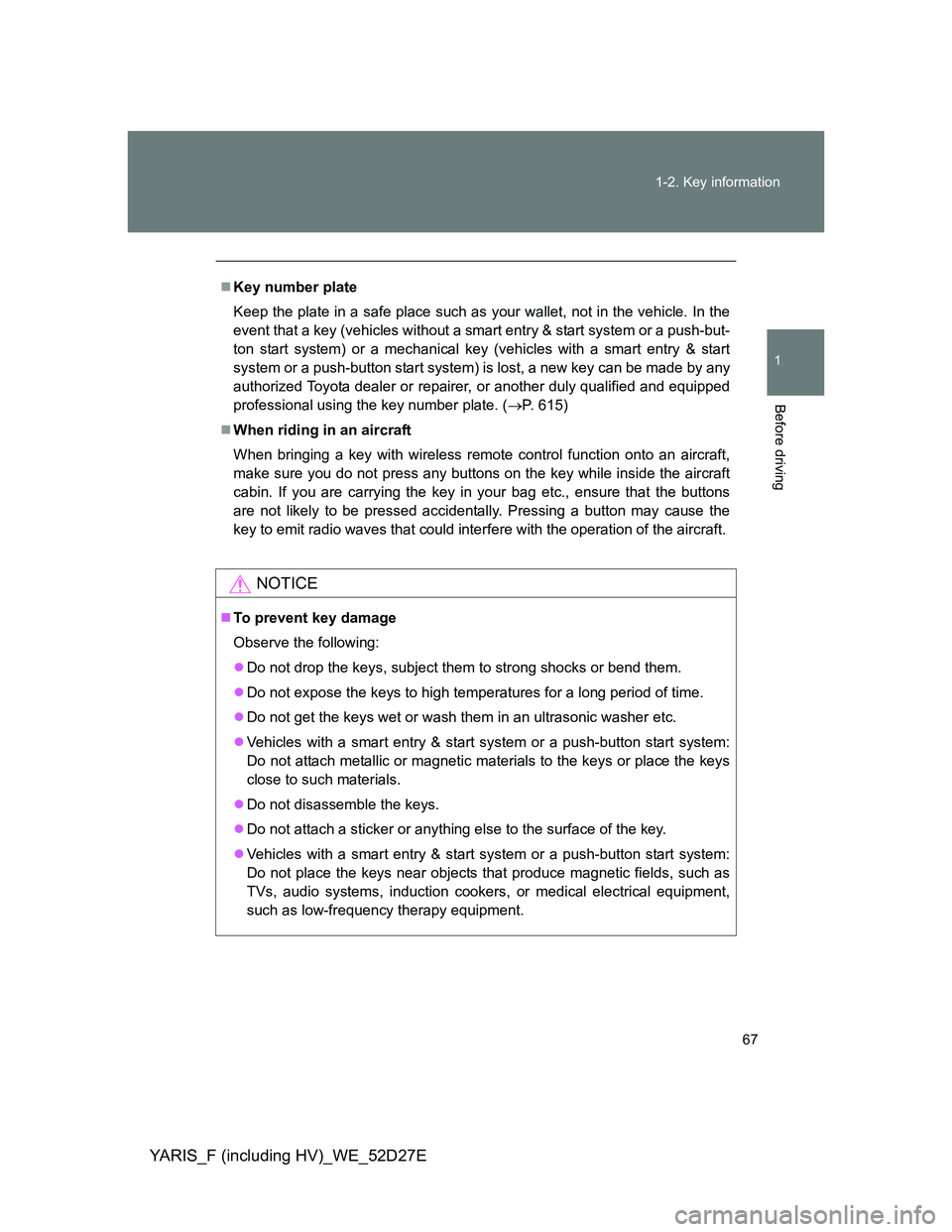
67 1-2. Key information
1
Before driving
YARIS_F (including HV)_WE_52D27E
Key number plate
Keep the plate in a safe place such as your wallet, not in the vehicle. In the
event that a key (vehicles without a smart entry & start system or a push-but-
ton start system) or a mechanical key (vehicles with a smart entry & start
system or a push-button start system) is lost, a new key can be made by any
authorized Toyota dealer or repairer, or another duly qualified and equipped
professional using the key number plate. (P. 615)
When riding in an aircraft
When bringing a key with wireless remote control function onto an aircraft,
make sure you do not press any buttons on the key while inside the aircraft
cabin. If you are carrying the key in your bag etc., ensure that the buttons
are not likely to be pressed accidentally. Pressing a button may cause the
key to emit radio waves that could interfere with the operation of the aircraft.
NOTICE
To prevent key damage
Observe the following:
Do not drop the keys, subject them to strong shocks or bend them.
Do not expose the keys to high temperatures for a long period of time.
Do not get the keys wet or wash them in an ultrasonic washer etc.
Vehicles with a smart entry & start system or a push-button start system:
Do not attach metallic or magnetic materials to the keys or place the keys
close to such materials.
Do not disassemble the keys.
Do not attach a sticker or anything else to the surface of the key.
Vehicles with a smart entry & start system or a push-button start system:
Do not place the keys near objects that produce magnetic fields, such as
TVs, audio systems, induction cookers, or medical electrical equipment,
such as low-frequency therapy equipment.
Page 68 of 700
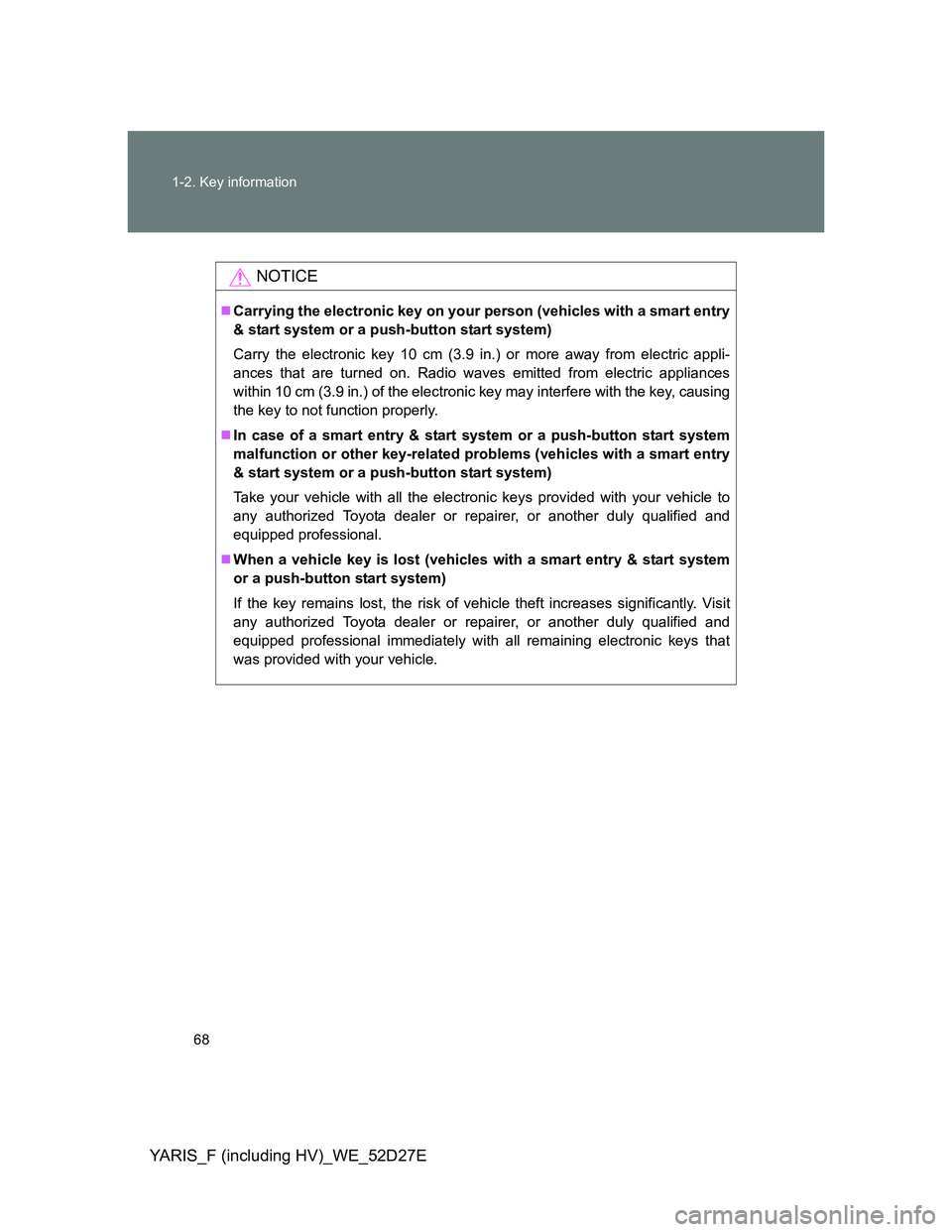
68 1-2. Key information
YARIS_F (including HV)_WE_52D27E
NOTICE
Carrying the electronic key on your person (vehicles with a smart entry
& start system or a push-button start system)
Carry the electronic key 10 cm (3.9 in.) or more away from electric appli-
ances that are turned on. Radio waves emitted from electric appliances
within 10 cm (3.9 in.) of the electronic key may interfere with the key, causing
the key to not function properly.
In case of a smart entry & start system or a push-button start system
malfunction or other key-related problems (vehicles with a smart entry
& start system or a push-button start system)
Take your vehicle with all the electronic keys provided with your vehicle to
any authorized Toyota dealer or repairer, or another duly qualified and
equipped professional.
When a vehicle key is lost (vehicles with a smart entry & start system
or a push-button start system)
If the key remains lost, the risk of vehicle theft increases significantly. Visit
any authorized Toyota dealer or repairer, or another duly qualified and
equipped professional immediately with all remaining electronic keys that
was provided with your vehicle.
Page 69 of 700
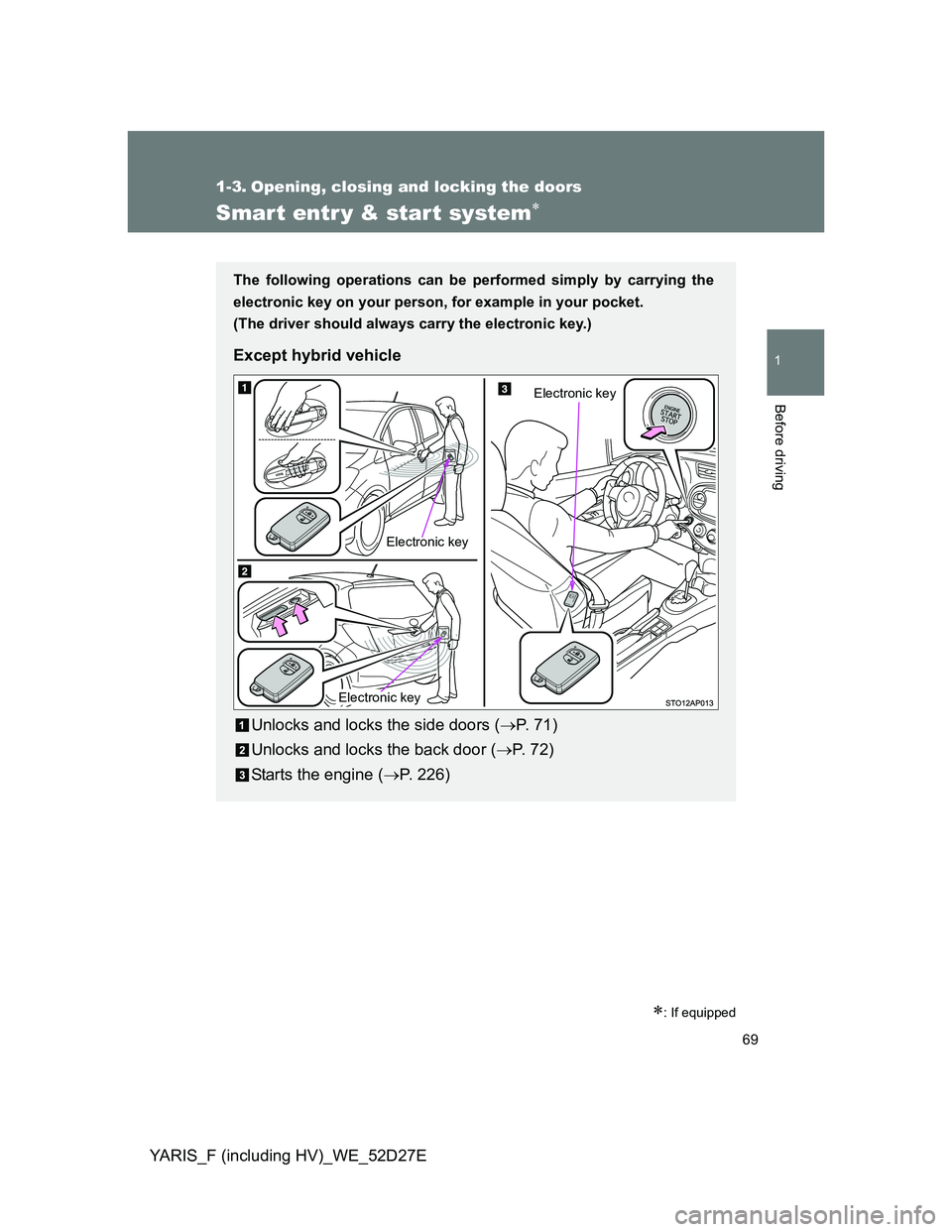
69
1
Before driving
YARIS_F (including HV)_WE_52D27E
1-3. Opening, closing and locking the doors
Smart entr y & start system
: If equipped
The following operations can be performed simply by carrying the
electronic key on your person, for example in your pocket.
(The driver should always carry the electronic key.)
Except hybrid vehicle
Unlocks and locks the side doors (P. 7 1 )
Unlocks and locks the back door (P. 72)
Starts the engine (P. 226)
Electronic key
Electronic keyElectronic key
Page 70 of 700
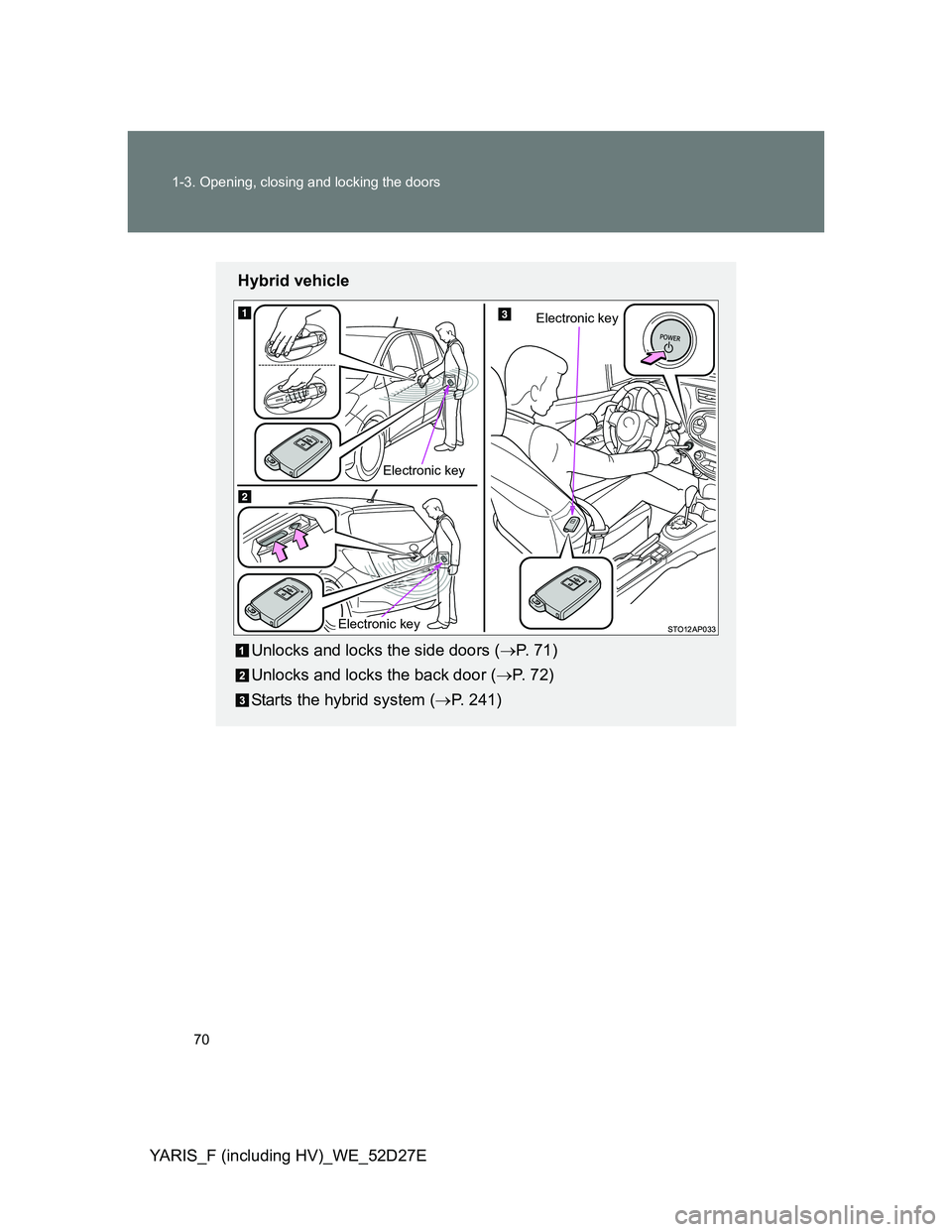
70 1-3. Opening, closing and locking the doors
YARIS_F (including HV)_WE_52D27E
Hybrid vehicle
Unlocks and locks the side doors (P. 7 1 )
Unlocks and locks the back door (P. 72)
Starts the hybrid system (P. 241)
Electronic key
Electronic key
Electronic key